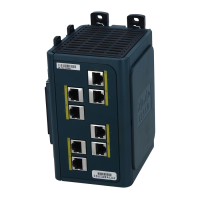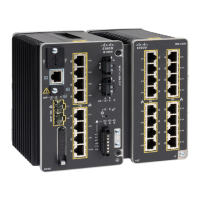26-20
Cisco IE 3000 Switch Software Configuration Guide
OL-13018-01
Chapter 26 Configuring SPAN and RSPAN
Configuring SPAN and RSPAN
This example shows how to configure VLAN 901 as the source remote VLAN and port 1 as the
destination interface:
Switch(config)# monitor session 1 source remote vlan 901
Switch(config)# monitor session 1 destination interface gigabitethernet1/1
Switch(config)# end
Creating an RSPAN Destination Session and Configuring Incoming Traffic
Beginning in privileged EXEC mode, follow these steps to create an RSPAN destination session, to
specify the source RSPAN VLAN and the destination port, and to enable incoming traffic on the
destination port for a network security device (such as a Cisco IDS Sensor Appliance).
For details about the keywords not related to incoming traffic, see the “Creating an RSPAN Destination
Session” section on page 26-19. This procedure assumes that the RSPAN VLAN has already
been configured.
Command Purpose
Step 1
configure terminal Enter global configuration mode.
Step 2
no monitor session {session_number | all |
local | remote}
Remove any existing SPAN configuration for the session.
Step 3
monitor session session_number source
remote vlan vlan-id
Specify the RSPAN session and the source RSPAN VLAN.
For session_number, the range is 1 to 66.
For vlan-id, specify the source RSPAN VLAN to monitor.
Step 4
monitor session session_number
destination {interface interface-id [, | -]
[ingress {dot1q vlan vlan-id | untagged vlan
vlan-id | vlan vlan-id}]}
Specify the SPAN session, the destination port, the packet
encapsulation, and the incoming VLAN and encapsulation.
For session_number, enter the number defined in Step 4.
In an RSPAN destination session, you must use the same session
number for the source RSPAN VLAN and the destination port.
For interface-id, specify the destination interface. The destination
interface must be a physical interface.
Though visible in the command-line help string, encapsulation
replicate is not supported for RSPAN. The original VLAN ID is
overwritten by the RSPAN VLAN ID, and all packets appear on the
destination port as untagged.
(Optional) [, | -] Specify a series or range of interfaces. Enter a space
before and after the comma; enter a space before and after the
hyphen.
Enter ingress with additional keywords to enable forwarding of
incoming traffic on the destination port and to specify the
encapsulation type:
• dot1q vlan vlan-id—Forward incoming packets with IEEE
802.1Q encapsulation with the specified VLAN as the default
VLAN.
• untagged vlan vlan-id or vlan vlan-id—Forward incoming
packets with untagged encapsulation type with the specified
VLAN as the default VLAN.

